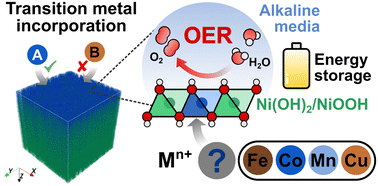Energy Environ. Sci., 2024, 17,2028-2045
DOI: 10.1039/D3EE03617K, Paper
DOI: 10.1039/D3EE03617K, Paper
 Open Access
Open Access This article is licensed under a Creative Commons Attribution-NonCommercial 3.0 Unported Licence.
This article is licensed under a Creative Commons Attribution-NonCommercial 3.0 Unported Licence.Raul A. Marquez, Emma Kalokowski, Michael Espinosa, Jay T. Bender, Yoon Jun Son, Kenta Kawashima, Chikaodili E. Chukwuneke, Lettie A. Smith, Hugo Celio, Andrei Dolocan, Xun Zhan, Nathaniel Miller, Delia J. Milliron, Joaquin Resasco, C. Buddie Mullins
Trace metal cations dissolved in alkaline electrolytes incorporate into nickel hydroxide/oxyhydroxide through in situ cation exchange, creating an interstratified structure near the surface of the material that impacts the electrochemical performance.
The content of this RSS Feed (c) The Royal Society of Chemistry
Trace metal cations dissolved in alkaline electrolytes incorporate into nickel hydroxide/oxyhydroxide through in situ cation exchange, creating an interstratified structure near the surface of the material that impacts the electrochemical performance.
The content of this RSS Feed (c) The Royal Society of Chemistry

